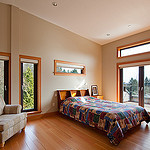Many of us understand the importance of consuming organic foods and making detoxification a regular part of our health routine. Creating a healthy home environment is also part of the detoxification /clean living process. After learning about the health hazards of dryer sheets and toxic cleaning products you may have already eliminated these items from your home, but what about the bedroom? What toxins may be lurking there?
We spend one third of our lives in a bedroom sleeping and many times this room contains products that are detrimental to our health. So if you want to create a healthy living environment, your bedroom may be a great place to start.
Start Small
Creating a clean (non-toxic) bedroom may be a financial challenge, so starting small is the easiest solution. Every change you can make will have a positive impact on your health. How you begin is a personal decision based on your budget and your own health issues. Some people begin with replacing their mattress, while others may choose to begin with something smaller such as an air cleaner or new bedding.
Some Changes to Ponder
1. Replace your pillows and pillow cases with organic materials, gradually working your way through the sheets, bedding, mattress and bed frame (if the frame is made from artificial products such as particle board or MDF, see #4 below). Many people make the mistake of assuming that cotton is a safer choice than synthetics, according to the Pesticide Action Network nearly $2.6 billion worth of pesticides are sprayed on cotton fields each year — accounting for more than 10% of total pesticide use and nearly 25% of insecticides use worldwide. (1) As your finances allow, replace your bedding with organic materials.
2. Replace or remove all artificial fabrics from your bedding, bedroom and closet. The reality is that synthetic materials such as acrylic, nylon, and polyester are made from thermoplastics. These fabrics out gas plastic molecules whenever they are heated, whether by a dryer or your own body heat. (2) If you wear wrinkle free clothes you’re breathing in plastic and formaldehyde. Remember that you also absorb these chemicals directly through your skin. The base for most synthetic fabrics is a liquid made from coal, oil, or natural gas. (3) The liquid is forced through the fine holes of a nozzle, called a spinneret. As the liquid emerges from the holes, it is cooled so that it solidifies to form tiny threads. These threads are woven together to make fabric, so the chemicals cannot be washed out. To make these clothes more durable Perfluorochemicals (PFCs), including Teflon are added to fabric to offer wrinkle and stain resistant qualities. (4) Look for clothing made of natural or organic materials. To learn more about synthetic clothes click here.
3. Remove faux /fabric furniture. If you have any furniture in your bedroom, such as a chair that is covered with artificial leather, it shouldn’t be in your bedroom or any room in your house for that matter. You may be surprised to learn that polyvinyl chloride (PVC), is often used in synthetic leather. PVC is widely regarded as the most dangerous of all plastics. It is made more flexible with the use of toxic plasticizers—typically phthalates, which are known endocrine disruptors, phthalates also increase the risk of allergy and asthma and have an adverse impact on children’s neurodevelopment (5) Throw pillows and seating cushions that are stain and water resistant have been sprayed with chemicals that are toxic. If the fabric is a cotton/polyester blend it was most likely treated with formaldehyde, and softened with ammonia. (6) Replace these when you can with organic or natural material. Don’t forget furniture made with particle board or MDF.
4. Remove particle board and MDF. If you have any furniture that is made of particle board, MDF or melamine, it shouldn’t be in your house, especially your bedroom. MDF is made with shredded wood that has been softened and powdered. The powder is combined with resins and other bonding agents and compacted into solid boards. The chemical that causes the most concern is formaldehyde, which can aggravate asthma and other lung conditions, irritate mucous membranes, and cause contact dermatitis. (7,9)
Like MDF, particle board contains formaldehyde, a known carcinogen that has been directly linked to nasopharyngeal carcinoma . The chemical can also cause headaches, allergies, nausea and a burning sensation in the throat. (8)
According to TLC, How Stuff Works, within two months, particle board decreases its toxicity by about 25%. By the end of the first year, particle board is only half as potent as it was new. It levels off from there and can take up to ten years to run completely out gas. (7, 9)
Look for solid wood furniture at furniture stores, flea markets and yard sales. Glass and metal end tables and desks generally work well as they don’t outgas and are easily wiped down.
5. Remove accent / throw rugs. Wood or tile floors are easiest to clean and better options for allergy/asthma and MCS sufferers. While small accent or area rugs may look nice in your bedroom, they hold onto dirt, dust mites and other allergens. If you can, omit rugs and carpet. Almost all polyester is manufactured with antimony, a carcinogen that is toxic to the heart, lungs, liver, and skin.(10) Many carpets are also made of olefin (polypropylene) or nylon, which is petroleum based synthetic fiber invented in the 1930’s by Dupont and is also commonly used in rugs.
6. Use No VOC Paint. If you decide to paint a room, use No VOC paint. VOCs (volatile organic compounds) are unstable, carbon-containing compounds that easily vaporize into the air. When they enter the air, they react with other elements to produce ozone, which causes air pollution and a host of health issues including respiratory problems, headache, burning, watery eyes and nausea. (11)
7. Shoe Free Zone. Consider making your home a shoe free zone. Have indoor and outdoor shoes to avoid tracking in pollen, dirt and chemicals from the outdoors in. You can also purchase a shoe or boot tray to keep by your door. When you come in from outdoors simply place your shoes in the tray to minimize dirt, pollen, dust and chemicals from being tracked into your house.
8. Minimize electrical devices. If you have a computer, TV or other electronic devices in your bedroom, you may consider moving them into another room. Electronic devices can disturb a peaceful night of sleep by disrupting sleep patterns. (12, 13) Switch out your digital alarm clock to a battery operated alarm clock.
9. Replace or Cover Your Mattress. Replacing your conventional mattress can be a financially challenging step as the cost of organic mattress can be cost prohibitive. The reality is that conventional mattresses are sprayed with flame retardant and stain resistant chemicals. Many mattresses are made of foam that can outgas for years. There are many sources for organic mattresses at local stores and online. Wherever you shop be aware of green washing. If you can’t afford to replace your mattress, you may consider an organic barrier cloth to encase your mattress and foundation.
10. Buy an air cleaner. If you can afford a whole house air cleaner, they are a wonderful investment. Do your research; there are a lot to choose from. For many people with a limited budget, a portable air cleaner that can be moved from room to room is a wonderful option. Look for one with HEPA filtration, and be sure that whatever you buy does not produce ozone. Some air cleaning companies will even custom blend their charcoal filters for specific needs such as allergy/asthma, smoke and MCS.
11. Remove chemically treated drapes or shades. Drapes and shades hold dust, pollen, and other allergens. If you can, remove drapes and shades and replace them with organic fabric drapes and shades. If the cost is prohibitive, consider bartering with a friend who can sew curtains or drapes for you. Wood blinds may also be an option for some individuals. If you are building a new home or remodeling you may consider blinds that are set in between the glass, no out gassing, and no weekly cleaning!
While this list may seem extensive, many of these changes are easily made over a period of time, rather than all at once. The options are worth considering if you or someone you know suffers with respiratory illness or environmental challenges. Keep in mind that any changes you can make will improve the air quality in your home. In time it will also improve your health, as you reduce your daily exposure to the many toxins used in everyday products.
References:
The Toxic Bedroom by Walter Bader
(1). http://www.panna.org/resources/cotton
(2) Home Safe Home by Debra Lynn Dadd
(3) http://www.infoplease.com/dk/science/encyclopedia/synthetic-fabrics.html
(4) http://www.motherearthliving.com/health-and-wellness/be-well-chemicals-that-stick-around.aspx
(6) http://www.audubonmagazine.org/audubonliving/audubonliving0911.html
(7). http://www.wisegeek.com/what-are-the-health-risks-of-mdf.htm
(8). http://www.cancer.gov/cancertopics/factsheet/Risk/formaldehyde
(9). http://tlc.howstuffworks.com/home/particle-board-safety.htm
(10). http://oecotextiles.wordpress.com/2010/02/17/will-the-antimony-in-polyester-fabric-hurt-me/
(11). http://home.howstuffworks.com/home-improvement/construction/materials/low-voc-paint.htm
(12). http://www.webmd.com/sleep-disorders/features/power-down-better-sleep
(13) http://www.thesleepjudge.com/different-ways-technology-affects-sleep-quality/








